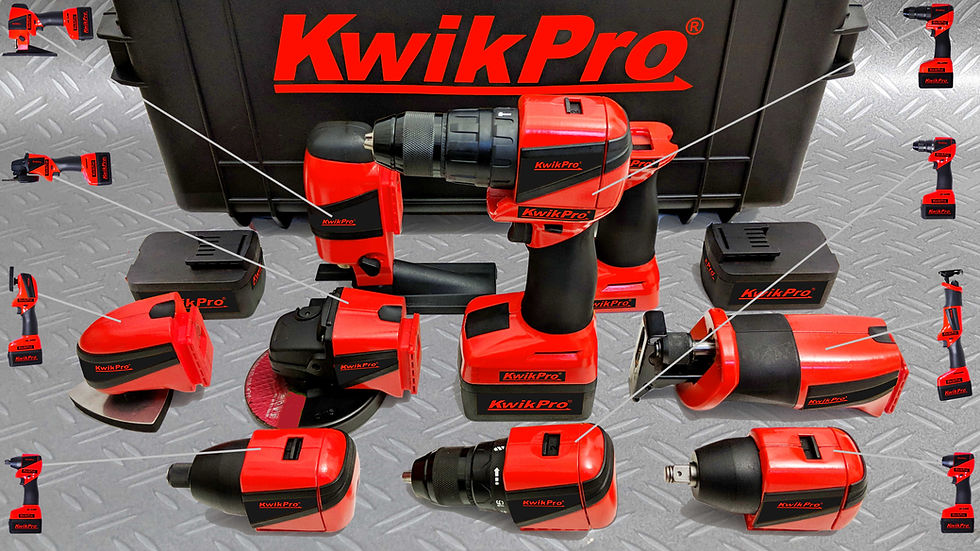Corded power tool power - a longer discussions
- Robert
- May 26, 2018
- 4 min read
What does the word power in power tools actually mean?
Without getting too technical, power tool mechanical power is all about rotational force and speed and power tool electrical power is about voltage and current. Rotational force is known as torque. It is a mistake to confuse force, torque or speed for the term power.
In power tool terms, a good example of how mechanical power works is a two gear power drill. The slow speed gear setting is not more powerful because it will drill larger holes and the faster gear setting is not less powerful because it can only drill smaller holes. The truth is that both gears produce approximately the same* power output because the motor power input is the same in both cases. However, in gear 1 the output torque (rotational force) is high and the output speed is low. In gear 2 the opposite is the case, the speed is high and the torque is low. When comparisons are made of how easily different power drills can turn a large drill bit, it is not how powerful the power tools are that is being compared but how much torque they can produce i.e. how torquey they are. (*Getting technical just for a moment: As with most things in life, this is an approximation and in reality because of the different efficiencies between the gears the power outputs may vary slightly but the principle is still correct).
An alternative example of how mechanical power works is to compare a powerful racing car, like a Formula 1 car or Indy car, with a tractor. Racing cars have very powerful engines but you wouldn't consider putting an F1 engine in a tractor to plough a field. A tractor engine, on the other hand is great for ploughing a field, but not much use for racing. Of the two, the racing car is likely to have much more power. But power is not what is required to plough a field. To plough a field you need force, and lots of it! You get force from an engine or a motor in the form of rotational force which is known as torque. A tractor engine has lots of torque, much more than a racing car engine, but much less power. How so? The engine of a racing car turns at much higher speed than a tractor engine. Mechanical engine power is the product of torque and speed. You might think of it as a ratio thing. So, although the racing car engine has much less torque than a tractor engine, because it has much more speed, it can have much more power. For example, if the racing car has twice the power of the tractor engine, that power might be made up of only a tenth of the torque that the tractor engine can produce but 20 times the rotational speed, or rpm. (Getting a bit techy again and doing the maths, you end up with 20 x speed: 1/10 torque = 2 x power.) Of course the amount of power and torque a tractor engine produces compared to a racing car engine is not the whole story. An F1 or Indy racing car has a lightweight engine which is designed to complete a race and then be rebuilt, it is not designed for heavy duty work. A tractor engine is designed to work day in day out every day without a rebuild. A racing car engine is very lightweight, runs very fast producing lots of speed but not much torque, and wears out! A tractor engine is heavy, runs slowly producing lots of torque but not so much power, and keeps going. Which do you want? It's a compromise and the same applies to power tools.
So, mechanical power is the combination of force and speed and electrical power is voltage and current. On a corded power tool the rating plate will often show a figure for the power. Usually this is measured in Watts or W and normally it does not relate to the mechanical power output from the power tool. Instead it relates to the amount of electrical power the motor draws from the electricity supply under standard controlled conditions. In other words it is a measure of the electrical power input. In many countries it is a regulatory requirement to show this power figure on anything that plugs into the mains electricity supply. It does not indicate how mechanically powerful the output of the power tool is. For example: a high quality corded power tool might have a lower power figure on the rating plate than a lower quality power tool but the higher quality power tool may work much better and produce more mechanical power output. How can this be? The lower quality power tool may be less power efficient and waste more power in the motor or gears or both. You may notice during use that the drill may get hotter. This is because it is wasting mechanical power in the form of heat due to higher electro-mechanical losses, usually as higher friction losses.
With cordless battery power tools things are more complicated and discussed in blog post: Cordless Tool Power
© Copyright 2018 - Power Tool Systems Limited - UK - www.kwikprotools.com



Comments